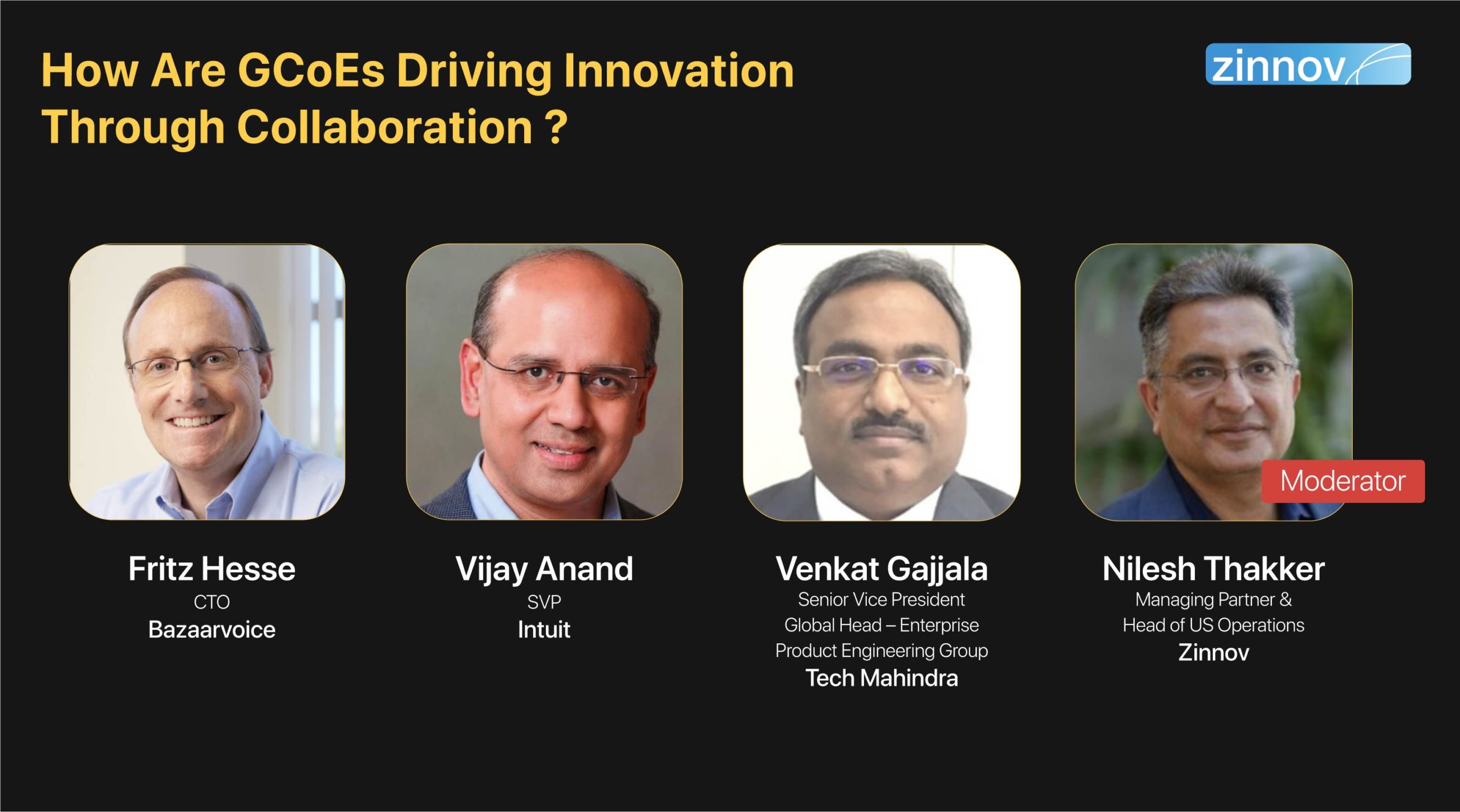|
|
A Center of Excellence is a unit of skilled resources that works across business units (BUs) or product lines within a BU and has bleeding-edge expertise in a particular domain. This elite unit of experts with niche skills works on breakthrough solutions, disseminates knowledge, and shares best practices across the organization. A Global GCC is therefore a key differentiator that helps organizations create a competitive advantage, and also a critical moat against disruptions. So, how do organizations formulate a robust strategy for the setting up and fostering innovation in GCCs, and drive outcomes at scale?
The following excerpts from a panel discussion held at the Zinnov Confluence 2020, US Edition, answers that critical question and much more.
The panelists include Fritz Hesse, CTO, Bazaarvoice; Vijay Anand, SVP, Intuit; and Venkat Gajjala, Senior Vice President, Global Head – Enterprise Product Engineering Group, Tech Mahindra, with session chair Nilesh Thakker, Managing Partner & Head of US Operations, Zinnov leading the discussion.

Nilesh: The definition of a GCC varies from company to company. What are your key goals for a GCC, and what are your GCCs solving for?
Fritz: Generally, we leverage GCCs for closing skills gap, cater to market demands, and address strategic and business needs. Four things that we solve for when we build a GCC are –
Vijay Anand: This is a talent game, and we have to attract the world’s best talent in order to deliver great solutions for customers and grow the business. That is the prime thing we are trying to solve for.
We ensure that we create an environment where the best talent can come together and deliver the best work through the following measures:
Nilesh: Venkat, you have a slightly different way of looking at the GCC construct. Can you talk about your goals and give some examples of the kind of GCCs you have set up in Tech Mahindra?
Venkat: I would divide the GCC experience into two categories:
From a technology point of view, we are clear on how we connect with the business objectives in terms of the market potential and what we need to solve for. And how do I look at some of the future technologies in the next 3 to 5 years and then start investing?
The right amount of incubation time is required to develop the right kind of solutions and partnerships. This will enable the process of addressing customer needs, fostering innovation in GCCs, and establishing a scalable GCC on a particular technology, cutting across verticals and geographies.
Nilesh: How do you make sure that the global GCCs are in alignment with the business strategy and are collaborating well with the teams at headquarters?
Fritz: We ensure alignment with the business strategy by following the traditional agile practices. We manage portfolios. We want to make sure that each location has as much autonomy and identity across a particular mission as possible, so that there are not too many dependencies. We’re all strategically aligned, and there’s a clear strategic plan that we have as a company.
Organizations are comprised of different departments, and different sites have responsibilities to deliver that. So we have tried to identify ways in which we can separate the work that doesn’t have daily dependencies, but at the same time, strategically aligned.
Nilesh: Vijay, you out of all of us, are the most experienced in building GCCs. What are some of the key success factors and pitfalls that leaders should look out for?
Vijay: This is a continuous learning journey and I can speak about from a product development standpoint. There are lots of lessons that we have learned along the way. Some basic ones are things that we encapsulate into what I call, ‘The Global Engineering Principles’ include:
A deliberate organization model helps us grow. These are lessons from our journey that we have now replicated in other locations – Tel Aviv, Canada, and so on.
Fritz: Just a couple of simple things to think about:
These are some of the potential pitfalls that organizations should look out for.
Nilesh: How have you used the local ecosystem to strengthen your GCCs?
Vijay: A dimension of the local ecosystem that we’re very passionate about, is the market. How do we get our people engaged with the local market?
We have our eyes and ears on the ground to be able to collaborate locally with customers, and our development centers around the world help us take our solutions to the various markets that we have today. This allows us to outlocal the locals. Being able to localize a product and make it right for the customer, is something all our centers do. This is the true power of having a distributed development presence.
Fritz: From a local standpoint, even for small companies, there is a huge opportunity to leverage local government grants that are interested in building talent and technology companies.
University and research grants are game-changers for smaller companies where they can tap into talent pools working on advanced research. For Bazaarvoice, we want to make sure that we are extensively leveraging the universities and the local government entities to grow our business and build a robust talent pipeline. Whether a company has the ability to sell in their local ecosystem is always going to be a challenge, depending on what products it would be looking at.
The most important goal of a GCC is to eliminate inefficiencies and help move the organization to the next level of maturity. GCCs do not just disseminate knowledge about the area of interest, but also provide employees with support for recommending best practices. In vertical industries, where knowledge management is a team’s primary responsibility, a GCC helps institutions and organizations to collaborate with each other to pursue excellence.